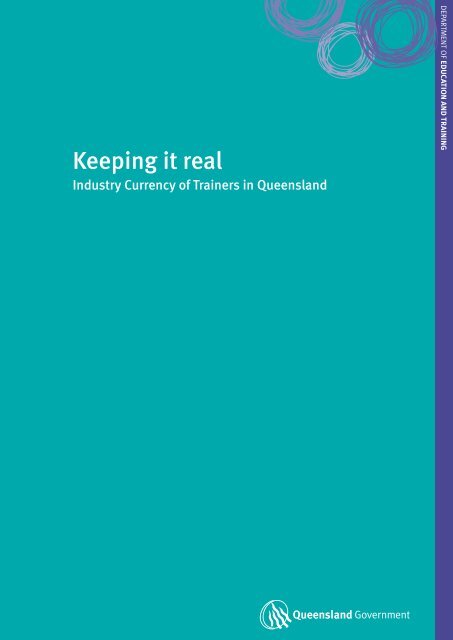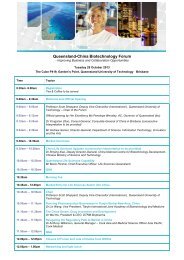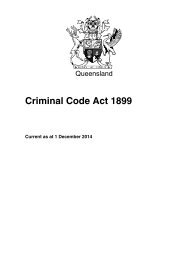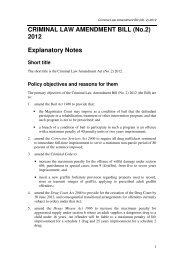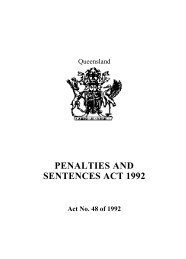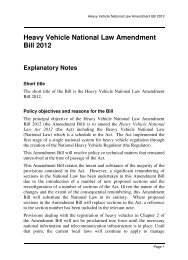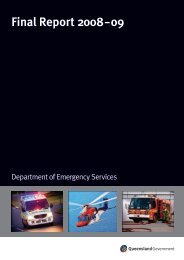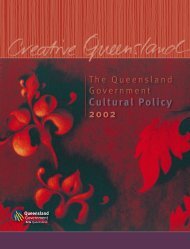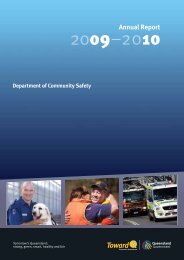Keeping it real - the Queensland VET Development Centre
Keeping it real - the Queensland VET Development Centre
Keeping it real - the Queensland VET Development Centre
- No tags were found...
Create successful ePaper yourself
Turn your PDF publications into a flip-book with our unique Google optimized e-Paper software.
Interviews were conducted at five <strong>Queensland</strong> TAFE inst<strong>it</strong>utes using a ‘vertical slice’ approach tosample staff at different levels w<strong>it</strong>hin <strong>the</strong> inst<strong>it</strong>ute hierarchy. The sample included a workplacetrainer, teacher, lead vocational teacher, educational manager/director and an administrativestaff member from <strong>the</strong> business improvement area. A different vocational training area wassampled at each inst<strong>it</strong>ute. The inst<strong>it</strong>ute sample included a metropol<strong>it</strong>an inst<strong>it</strong>ute, a specialistinst<strong>it</strong>ute, a near metropol<strong>it</strong>an inst<strong>it</strong>ute and two regional inst<strong>it</strong>utes.Five <strong>Queensland</strong> registered private RTOs were consulted and a similar ‘vertical slice’ approachwas used where possible in selecting <strong>the</strong> sample staff for interview. The sample of private RTOsincluded two large providers and three small providers. 3 Interviews were also conducted w<strong>it</strong>h arange of o<strong>the</strong>r <strong>VET</strong> stakeholders including industry skills alliances, industry clients of RTOs, andunion delegates.The research team received surveys from 123 people, of whom 18 were RTO managers, 98 weretrainers in RTOs and <strong>the</strong> remainder were from o<strong>the</strong>r <strong>VET</strong> stakeholder groups. The RTO staff work ina variety of vocational training areas. A breakdown of trainer respondents by vocational trainingareas is included in Table 1 (at Appendix 3). The research team interviewed 57 people, of whom15 were RTO managers and 23 were trainers.More detail about <strong>the</strong> interview respondents is provided in Table 2 (Appendix 3). There was a totalof 180 responses received through interviews and questionnaires; 25 from private RTOs, 119from public RTOs, 10 involved in schools and o<strong>the</strong>r <strong>VET</strong> stakeholders.The range of issues and concerns identified during both <strong>the</strong> interviews and <strong>the</strong> survey wasbroadly consistent. Therefore this paper makes no differentiation between survey and interviewrespondents.3 For <strong>the</strong> purposes of this research RTO size was defined as follows: small RTO (1-5 trainers), medium RTO (6-20 trainers) and large RTO (21 +trainers).Industry Currency of Trainers in <strong>Queensland</strong>5
Key findings and issuesIn <strong>the</strong> course of wr<strong>it</strong>ing this report, some key <strong>the</strong>mes about industry currency emerged. The reportanalyses issues under <strong>the</strong>se <strong>the</strong>mes (or headings), highlights key findings and identifies areasneeding fur<strong>the</strong>r investigation.The findings from this research were broadly consistent w<strong>it</strong>h findings in <strong>the</strong> l<strong>it</strong>erature, most notably in:• Cavanagh, B. (2006) Considering Currency• Clayton, B., Fisher, T., & Hughes, E. (2005) Sustaining <strong>the</strong> skill base of technical and fur<strong>the</strong>reducation inst<strong>it</strong>utes: TAFE managers’ perspectives• Harris, R., Simons, M., & Clayton, B. (2005), Shifting mindsets: The changing work roles ofvocational education and training pract<strong>it</strong>ioners• Toner, P. (2005), <strong>Keeping</strong> up w<strong>it</strong>h technology. A pilot study of TAFE and <strong>the</strong> manufacturingsectorAustralian Qual<strong>it</strong>y Training Framework and industry currencyThe Australian Qual<strong>it</strong>y Training Framework (AQTF) 2007 Essential Standards for Registrationincludes a strong focus on continuous improvement. AQTF Element 1.4 requires trainers tomaintain and improve <strong>the</strong>ir teaching skills and <strong>the</strong>ir industry currency of technical skills andknowledge. The specific AQTF focus on <strong>the</strong> industry currency of training staff seems to haveincreased RTO attention on this matter. RTO managers appear to be more aware of <strong>the</strong> need tohave su<strong>it</strong>able systems in place to recognise, plan and support industry currency requirements.However feedback indicated that decisions in RTOs about what is recorded as industry currencyare often compliance driven ra<strong>the</strong>r than focusing on continuous improvement which is <strong>the</strong> aim of<strong>the</strong> AQTF.Key Finding 1The focus of AQTF Element 1.4 on <strong>the</strong> industry currency of training staff has increased RTOattention on <strong>the</strong> need to maintain industry skills and knowledge.Defining and measuring industry currency of technical skills and knowledgeMoy (2001) defines industry currency as maintaining, upgrading and if required, wideningcompetence in <strong>the</strong> specialised industry skills and knowledge needed by trainers to deliver andassess vocational education and training (<strong>VET</strong>) courses.The <strong>Queensland</strong> Strategic Professional <strong>Development</strong> project (2003) defin<strong>it</strong>ion went fur<strong>the</strong>r toinclude technologies, industry practices and workplace issues, views, prior<strong>it</strong>ies or needs. Whiledefin<strong>it</strong>ions exist, <strong>the</strong>re are no standard quantifiable measures to assist RTOs to evaluate andbenchmark trainer industry currency.The consultations from this research indicate <strong>the</strong>re is a wide variation in understanding among<strong>Queensland</strong> <strong>VET</strong> stakeholders about what is required to demonstrate industry currency and howbest to maintain <strong>it</strong>. Some trainers do not acknowledge <strong>the</strong> need for industry currency at all, whileo<strong>the</strong>rs use very sophisticated approaches to improve industry currency both w<strong>it</strong>hin <strong>the</strong>ir ownorganisation and <strong>the</strong>ir local industry.Some trainers who were teaching in general education and support areas, for example Englishas a Second Language (ESL) and L<strong>it</strong>eracy and Numeracy courses, find <strong>it</strong> difficult to define <strong>the</strong>irindustry and consequently identify appropriate industry currency activ<strong>it</strong>ies.6 <strong>Keeping</strong> <strong>it</strong> <strong>real</strong>
Benef<strong>it</strong>s identified in maintaining industry currency include:• <strong>the</strong> delivery of training that is relevant, based on <strong>real</strong> world examples and more tailored toindustry needs• improved teaching, learning and assessment practices• improved confidence and an up-to-date and best practice image of trainers for students,industry and peers• improved reputation of <strong>the</strong> RTO amongst employers• enhanced industry confidence and goodwill - through being ‘seen’ in industry• improved industry ownership, valuing and understanding of training.Industry-current trainers identified <strong>the</strong> value of relationships w<strong>it</strong>h industry and employers.These trainers considered <strong>the</strong> development and maintenance of industry relationships to be partof <strong>the</strong>ir professional responsibil<strong>it</strong>y as a trainer. However, some trainers did not think that industryengagement for industry currency and relationship building purposes was as highly valued by<strong>the</strong>ir RTO as increasing <strong>the</strong> number of training hours provided.Some trainers who regularly engage w<strong>it</strong>h <strong>the</strong>ir industry reported add<strong>it</strong>ional benef<strong>it</strong>s to <strong>the</strong>ir RTOfrom maintaining industry relationships such as opportun<strong>it</strong>ies to train and upskill o<strong>the</strong>r staff ofemployers.“It is expected that as a professional, I will take ownership of this responsibil<strong>it</strong>y and drive<strong>the</strong> process to ensure that I am able to take full advantage of any opportun<strong>it</strong>ies to maintainmy industry currency.” – RTO Trainer“The benef<strong>it</strong>s of being in contact w<strong>it</strong>h your industry are numerous; gaining a rapport w<strong>it</strong>hemployers and <strong>the</strong> supervisors <strong>the</strong>y employ, observing and discussing innovation w<strong>it</strong>hworkers at <strong>the</strong> coal face, collecting materials and data to be used in <strong>the</strong> training processat <strong>the</strong> RTO in which I work, being able to market services that my RTO has to offer to o<strong>the</strong>rstaff members not just apprentices.” – RTO TrainerWhile industry provides strategic advice to <strong>the</strong> <strong>VET</strong> sector on industry standards, some trainersreported that <strong>the</strong>ir local employers rely on <strong>the</strong> trainers to provide advice on current and bestindustry practice. This may be particularly relevant for small and medium size employers who arenot engaged w<strong>it</strong>h peak industry bodies and <strong>the</strong> training agenda.Key Finding 5The maintenance of industry currency benef<strong>it</strong>s <strong>the</strong> trainer, <strong>the</strong> RTO, students and industry.Key Finding 6Sophisticated industry currency strategies value relationships w<strong>it</strong>h industry and employers andseek to collaboratively improve practices both w<strong>it</strong>hin RTOs and <strong>the</strong>ir local industry.How trainers and assessors maintain <strong>the</strong>ir industry currency<strong>Queensland</strong> trainers undertake a range of activ<strong>it</strong>ies to maintain and increase <strong>the</strong>ir technical skillsand knowledge and maintain <strong>the</strong>ir industry currency. The range of activ<strong>it</strong>ies includes:• industry placement• concurrent employment in industry and <strong>the</strong> RTO• industry and professional association membership• attending conferences, professional workshops and industry specific developmentprogrammes• attending professional development activ<strong>it</strong>ies run by industry skills alliances• researching best and new practice and general research• subscribing to professional journals and publications8 <strong>Keeping</strong> <strong>it</strong> <strong>real</strong>
• applying for sponsored corporate teaching awards and scholarships• networking w<strong>it</strong>h industry mentors, employers and o<strong>the</strong>r trainers• talking to students about practices and job roles in <strong>the</strong>ir workplaces• industry specialist vis<strong>it</strong>s, industry s<strong>it</strong>e vis<strong>it</strong>s and study tours• undertaking specific training courses in new equipment or skill sets• work shadowing• fulfilling industry licensing or regulatory requirements.Opportun<strong>it</strong>ies such as research scholarships, overseas sabbaticals, interstate assignments, workshadowing and industry projects could also be considered when planning industry currencyactiv<strong>it</strong>ies.Key Finding 7Industry currency is a progressive and continual process involving a rich variety of activ<strong>it</strong>ies.The relevance of <strong>the</strong>se activ<strong>it</strong>ies may vary according to <strong>the</strong> individual industry and educationalcontext.Most trainers thought industry currency activ<strong>it</strong>ies should involve best and new practice and <strong>the</strong>development of higher level skills, not just maintaining existing practice in local areas and lowerlevel skills. They suggested that industry identify good practice workplaces where trainers couldgain industry experience.Some trainers thought that some of <strong>the</strong> work <strong>the</strong>y do w<strong>it</strong>hin RTOs should be recognised asmaintaining <strong>the</strong>ir skills for industry currency. They said that transferable skills, like managementskills, although demonstrated and maintained outside of <strong>the</strong>ir industry, should be recognised.“I firmly believe that non-teaching duties that appropriately reflect skills and attributesappropriate to my industry area of business and management should be given equalcred<strong>it</strong> in building and maintaining industry currency. At present none of <strong>the</strong>se activ<strong>it</strong>ies isconsidered when evaluating my currency in industry.” – RTO TrainerSome of <strong>the</strong> activ<strong>it</strong>ies that trainers are undertaking to maintain <strong>the</strong>ir industry currency arediscussed in more detail below.• Industry placementA number of respondents related industry currency to industry placement, which is referred to as‘release to industry’ in TAFE inst<strong>it</strong>utes. The <strong>Queensland</strong> TAFE Teachers’ Award 2003 State definesrelease to industry as, ‘release from inst<strong>it</strong>ute attendance for observational, research or hands-onexperience in an external organisation w<strong>it</strong>hin industry, commerce or o<strong>the</strong>r appropriate setting for<strong>the</strong> specific purpose of acquiring skills, knowledge and experience necessary for staff members toimprove <strong>the</strong> qual<strong>it</strong>y of technical and fur<strong>the</strong>r education.’ (Schedule 2)Where industry placement was used as a strategy for maintaining industry currency, <strong>the</strong> major<strong>it</strong>yof public trainers surveyed appeared to access <strong>it</strong> for short periods of time only. This may bebecause <strong>the</strong> TAFE Teachers’ Award specifies that ‘All Permanent Teachers, Leading VocationalTeachers, Principal Teachers and Tutors covered by this Award shall be ent<strong>it</strong>led to a minimumperiod of 10 days per year for <strong>the</strong> purpose of professional development, including releaseto industry, subject to appropriate professional development opportun<strong>it</strong>ies being available.’(Section 9.2.1 and Schedule 2)While <strong>the</strong> award refers to a minimum of 10 days, 10 was often referred to by many respondents tobe <strong>the</strong> maximum number of days available for professional development. Planning for professionaldevelopment in educational practice and industry currency was often lim<strong>it</strong>ed to this 10 daytimeframe. Although private RTOs are not subject to this award, some have adopted 10 days as abenchmark.Industry Currency of Trainers in <strong>Queensland</strong>9
A common practice in TAFE inst<strong>it</strong>utes, according to those consulted, seems to involve dividing <strong>the</strong> 10days into 5 days for industry currency, 2 days for <strong>the</strong> whole-of-inst<strong>it</strong>ute staff development days, w<strong>it</strong>h<strong>the</strong> remaining days available for o<strong>the</strong>r professional development. Some respondents reported that<strong>the</strong> whole-of-inst<strong>it</strong>ute staff development days covered generic topics which do not directly contributeto professional development in training or industry currency. They thought that generic professionaldevelopment should not be attributed to <strong>the</strong> 10 days of professional development. This was because<strong>it</strong> did not meet <strong>the</strong>ir particular training needs for industry currency purposes.Opinions about <strong>the</strong> ideal length and frequency of industry placement varied across vocational trainingareas. Respondents from vocational training areas w<strong>it</strong>h regular industry changes argued that trainersshould undertake industry placement every year in order to maintain <strong>the</strong>ir skills at industry standard.Those from industries w<strong>it</strong>h a slower rate of change thought industry placement could be less frequent,for example every 3 years.There were also differences in opinion about <strong>the</strong> length of time trainers should spend in industryplacements. For example, single days interm<strong>it</strong>tently throughout <strong>the</strong> year were considered appropriatefor service industries, whereas <strong>it</strong> was perceived that blocks of two weeks or more would be best inindustries w<strong>it</strong>h longer term project based work such as construction. A few trainers have soughtlonger placements of six months to a year in industry to improve <strong>the</strong>ir industry knowledge, skills andexperience.Many respondents expressed an interest in undertaking regular industry placements w<strong>it</strong>hin differentworkplaces to experience different market segments w<strong>it</strong>hin <strong>the</strong>ir industry. However for some trainers,particularly those w<strong>it</strong>hout strong industry networks, finding industry placement opportun<strong>it</strong>ies isdifficult.Timing of industry placement is ano<strong>the</strong>r issue for trainers. Some stated that <strong>it</strong> can be difficult to finda time that is convenient to both <strong>the</strong> RTO and <strong>the</strong> industry, particularly when <strong>the</strong> ‘down time’ periodscoincide, for example, <strong>the</strong> building industry and RTO Christmas closure.Key Finding 8Opinions about <strong>the</strong> ideal duration and frequency of industry placement vary.• Industry employmentA number of respondents reported an increased focus by RTO managers on recent industry experienceor part-time industry employment to meet AQTF Element 1.4 industry currency requirements.Respondents maintained <strong>the</strong>re are many ways for trainers to gain industry experience — includingself-employment, working in a family business, part-time or casual employment, using <strong>the</strong>ir networksor even volunteering. However, feedback from <strong>VET</strong> stakeholders indicates that some TAFE managersdo not accept some of <strong>the</strong>se activ<strong>it</strong>ies as relevant to industry currency, particularly where <strong>the</strong>re is aperceived conflict of interest.Attributing <strong>the</strong> trainer’s self-employment as <strong>the</strong> sole source of industry currency was challenged bysome managers. They argue that self-employment provides lim<strong>it</strong>ed opportun<strong>it</strong>ies for exposure tonew ideas, skills and processes — opportun<strong>it</strong>ies that may be available when working in a differentworkplace. As well, <strong>the</strong>y maintain that self-employment does not provide experience in differentmarket segments w<strong>it</strong>hin <strong>the</strong> trainer’s industry area.These considerations were not reported as issues by <strong>the</strong> respondents from private RTOs.10 <strong>Keeping</strong> <strong>it</strong> <strong>real</strong>
Key Finding 9Industry placement and employment comprise just one mechanism for maintaining industrycurrency.Exchange programsAs <strong>the</strong> <strong>Queensland</strong> Skills Plan Action 4.1.1.1 specifically refers to <strong>the</strong> ‘development of exchangeand mobil<strong>it</strong>y programs between industry and <strong>VET</strong> trainers’ <strong>the</strong> research team asked intervieweesfor examples of mobil<strong>it</strong>y programs or exchanges. Interviewees expressed interest in exchange as aconcept, but were not aware of any current examples.Interviewees were asked about <strong>the</strong> feasibil<strong>it</strong>y of a direct exchange of job roles between industry and<strong>VET</strong>. Some respondents believed that while a trainer could quickly update <strong>the</strong>ir skills to industrystandards, <strong>it</strong> may take longer for someone w<strong>it</strong>h industry skills and no educational training to becomea competent trainer.The concept of exchange programs and <strong>the</strong> scope of activ<strong>it</strong>ies that could be undertaken were notwell understood. The use of exchange programs as an industry currency mechanism needs fur<strong>the</strong>rinvestigation and defin<strong>it</strong>ion to be considered as a viable mechanism to improve industry currency.Key Finding 10Fur<strong>the</strong>r research is required into exchange programs to identify <strong>the</strong> range of activ<strong>it</strong>ies orprojects that could be undertaken, <strong>the</strong>ir accessibil<strong>it</strong>y and sustainabil<strong>it</strong>y.Industry led engagement w<strong>it</strong>h trainersTrainer industry currency is of mutual benef<strong>it</strong> and importance to both industry and training outcomes.It is v<strong>it</strong>al for industry to provide meaningful opportun<strong>it</strong>ies for trainers to maintain <strong>the</strong>ir industry skillsand knowledge.Currently <strong>the</strong> onus for industry engagement largely falls on <strong>the</strong> trainer or RTO. Most industry groupsdo not proactively involve RTO staff in industry professional development activ<strong>it</strong>ies. The research didindicate, however, that some industries engage more proactively w<strong>it</strong>h trainers, acknowledging <strong>the</strong>mas an important sector of <strong>the</strong>ir industry.How one industry approaches maintenance of industry currencyThe hairdressing industry proactively engages w<strong>it</strong>h <strong>it</strong>s trainers, assisting <strong>the</strong>m in manydifferent ways to keep up to date w<strong>it</strong>h <strong>the</strong> latest trends, practices and products. Thehairdressing trainers surveyed were highly engaged in a broad range of activ<strong>it</strong>ies tomaintain <strong>the</strong>ir industry currency.One of <strong>the</strong> major ways <strong>the</strong> hairdressing industry keeps <strong>it</strong>s staff and trainers current isthrough expo events such as <strong>the</strong> 3 day Hair Expo held in Sydney each year. This eventprovides delegates w<strong>it</strong>h <strong>the</strong> opportun<strong>it</strong>y to participate in hands-on workshops, learn newtechniques and update industry knowledge by watching and learning from top national andinternational hairdressers. Over 100 hair and beauty companies are represented and <strong>the</strong>event includes motivational and business speakers.Hairdressing product companies vis<strong>it</strong> RTOs throughout <strong>the</strong> year to talk w<strong>it</strong>h trainers andfacil<strong>it</strong>ate workshops featuring <strong>the</strong> latest techniques and products. Companies designprograms specifically for trainers and allow trainers to participate in <strong>the</strong> specialist industrytraining <strong>the</strong>y deliver.Industry Currency of Trainers in <strong>Queensland</strong>11
Professional ident<strong>it</strong>y of <strong>VET</strong> trainersThe <strong>VET</strong> sector is unique in <strong>it</strong>s requirement for trainers to possess and maintain skills andqualifications in both industry and training. Some respondents expressed difficulty in allocating<strong>the</strong> time required to maintain <strong>the</strong> dual professional requirements of <strong>the</strong> role.The approach to industry currency and <strong>the</strong> value assigned to <strong>it</strong>s maintenance appeared tobe linked to whe<strong>the</strong>r <strong>the</strong> trainer considered maintaining industry currency to be part of <strong>the</strong>irprofessional ident<strong>it</strong>y. Trainers who identified industry currency as an essential component of <strong>the</strong>irprofessional ident<strong>it</strong>y were easily able to articulate <strong>the</strong> value of industry currency to <strong>the</strong>mselves,<strong>the</strong>ir RTO, <strong>the</strong>ir students and <strong>the</strong>ir industry. They embraced <strong>the</strong>ir dual role as a trainer and anindustry person and took ownership over <strong>the</strong> process of maintaining <strong>the</strong>ir own industry currency.Trainers who worked in teams/RTOs w<strong>it</strong>h a strong industry currency culture were pos<strong>it</strong>ive andenthusiastic about maintaining <strong>the</strong>ir industry currency. They sought new and innovative ways ofengaging w<strong>it</strong>h <strong>the</strong>ir local employers to promote, streng<strong>the</strong>n and raise professional standards inboth <strong>the</strong> industry and training. Some examples of <strong>the</strong>se activ<strong>it</strong>ies include:• organising events featuring recognised industry leaders for RTO staff, students and localemployers• organising compet<strong>it</strong>ions featuring <strong>the</strong> skills of students, RTO staff and employees of localindustry that are judged by recognised industry leaders.A few of <strong>the</strong> trainers who were comm<strong>it</strong>ted to maintaining <strong>the</strong>ir industry currency but workedin teams/RTOs that did not have a strong industry currency culture, expressed frustration anddisappointment at <strong>the</strong> lack of support and enthusiasm from <strong>the</strong>ir colleagues. This frustration wasoften linked to:• out-of-date knowledge of industry practice being delivered by colleagues• lack of support to ‘upskill’ colleagues• lack of organisational response to staff who do not maintain <strong>the</strong>ir industry currency, especiallywhen <strong>the</strong>re are pay par<strong>it</strong>y, tenure and/or hierarchical differences.Key Finding 11Trainers who identified industry currency as an essential component of <strong>the</strong>ir professionalident<strong>it</strong>y were easily able to articulate <strong>the</strong> value of industry currency to <strong>the</strong>mselves, <strong>the</strong>ir RTO,<strong>the</strong>ir students and <strong>the</strong>ir industry. These trainers owned <strong>the</strong> responsibil<strong>it</strong>y for maintaining <strong>the</strong>irindustry currency, using a rich and varied range of activ<strong>it</strong>ies to achieve this outcome.The potential of linking training in <strong>the</strong> workplace w<strong>it</strong>h industry currencyAll respondents were asked whe<strong>the</strong>r and how training and assessing in <strong>the</strong> workplace contributesto industry currency.“Only to a small degree because <strong>the</strong> trainer does not complete any actual work in that fieldto maintain skills. Skills are practical operations and to justify maintenance of practicalskill you would be required to perform <strong>the</strong> tasks frequently especially if <strong>the</strong> trainer isexpected to be at current industry standard w<strong>it</strong>h contemporary practices and processes,including technological development.” – Industry representative“Yes – <strong>the</strong> ongoing delivery of training and assessment in partnership w<strong>it</strong>h employers ina workplace ensures that <strong>the</strong> trainer/assessor is exposed to <strong>the</strong> current technologies/equipment, and is required to develop <strong>the</strong> training and conduct <strong>the</strong> assessment in amanner relevant to <strong>the</strong> workplace.” – Industry representative12 <strong>Keeping</strong> <strong>it</strong> <strong>real</strong>
“The system will not allow me to document on <strong>the</strong> job assessments as keeping up mycurrency, yet what better way is <strong>the</strong>re to keep up currency? When I am doing on <strong>the</strong> jobassessments I have copies of <strong>the</strong> workplace standard operating procedures and any machinemanuals that I may need but I would not get access to <strong>the</strong>se documents if I just went intoindustry for day release.” – RTO TrainerThere was general agreement by <strong>VET</strong> stakeholders that workplace training and assessmentcontributes to industry currency when <strong>the</strong> trainer forms a relationship w<strong>it</strong>h <strong>the</strong> organisation andbecomes familiar w<strong>it</strong>h policies and processes, job roles and industry practices.Key Finding 12W<strong>it</strong>h an increase in <strong>the</strong> demand for workplace delivery, fur<strong>the</strong>r work is required to identifyappropriate ways of using workplace training and assessment as a means of maintainingindustry currency.Barriers to trainers maintaining <strong>the</strong>ir industry currencyThe research identified that <strong>Queensland</strong> trainers experience significant barriers to maintainingindustry currency. Some barriers are experienced at RTO level, o<strong>the</strong>rs at <strong>the</strong> industry level and a feware personal.Barriers identified w<strong>it</strong>hin <strong>the</strong> RTO include:• lim<strong>it</strong>ed access to industry currency activ<strong>it</strong>ies• lim<strong>it</strong>ed contact between trainers, students and employers due to siloing of functions w<strong>it</strong>hin RTOs• lack of support for trainer engagement w<strong>it</strong>h industry• lim<strong>it</strong>ed RTO support for trainer absences from <strong>the</strong> workplace• complex<strong>it</strong>ies providing replacement trainers• lim<strong>it</strong>ed budget for industry currency maintenance, for example, planning, salaries of staff andreplacement trainer/s• add<strong>it</strong>ional travel costs for regional RTOs to access professional development in metropol<strong>it</strong>anareas• outdated resources or equipment.Industry barriers include:• lim<strong>it</strong>ed opportun<strong>it</strong>ies for meaningful industry experience• lim<strong>it</strong>ed industry placement opportun<strong>it</strong>ies in local industries• lim<strong>it</strong>ed capac<strong>it</strong>y of local industry to provide access to new technology, equipment and processes.Personal barriers include:• expectations of RTO managers that trainers would take on part-time industry employment• balancing family/life comm<strong>it</strong>ments w<strong>it</strong>h industry currency expectations• <strong>the</strong> use of own time and money for industry currency activ<strong>it</strong>ies• a lack of clar<strong>it</strong>y in public RTOs around leave arrangements including <strong>the</strong> use of non attendancetime• not having <strong>the</strong> current industry contacts required to develop and maintain industry currency• att<strong>it</strong>udes that undervalue <strong>the</strong> importance of industry currency.Some of <strong>the</strong>se barriers are discussed in more detail below.• Lim<strong>it</strong>ed access to industry currency activ<strong>it</strong>iesAccording to AQTF requirements teachers and workplace trainers have an obligation to maintainindustry currency. However, access to professional development differs according to industrial awardcond<strong>it</strong>ions and tenure arrangements (whe<strong>the</strong>r you are permanent, contract or casual).Industry Currency of Trainers in <strong>Queensland</strong>13
Workplace trainers in some TAFE inst<strong>it</strong>utes may not have <strong>the</strong> same access to professionaldevelopment and release to industry as teachers because <strong>the</strong>y are employed under different awardsw<strong>it</strong>h different ent<strong>it</strong>lements.Respondents also indicated that reduced access to opportun<strong>it</strong>ies to maintain industry currency islikely to be an issue for casual, part-time and contract employees. Some RTO managers assumethat casual, part-time and contract employees are working in industry and <strong>the</strong>refore do not requireaccess w<strong>it</strong>hin RTO work time to professional development for industry currency reasons.A number of <strong>the</strong>se staff indicated that <strong>the</strong>y had to pay for <strong>the</strong>ir own professional development andattend <strong>it</strong> in <strong>the</strong>ir own time.Key Finding 13Better planning is required to ensure contract, casual and part-time staff have access toopportun<strong>it</strong>ies to improve industry currency.• Lim<strong>it</strong>ed contact between trainers, students and employers due to siloing of functions w<strong>it</strong>hin RTOsThe siloing of functions w<strong>it</strong>hin large RTOs, means that some trainers do not have contact w<strong>it</strong>hstudents or employers prior to or following <strong>the</strong> delivery of training. In fact, some trainers may neverhave any contact w<strong>it</strong>h <strong>the</strong> students’ employers unless <strong>the</strong>re is an issue w<strong>it</strong>h <strong>the</strong> student’s training.Prior contact w<strong>it</strong>h students and employers would enable trainers to gain an understanding of <strong>the</strong>student’s workplace, general workplace issues and <strong>the</strong> employer’s expectations of training. Thetrainer could <strong>the</strong>n tailor training to meet <strong>the</strong>se needs. Contact post delivery would allow <strong>the</strong> trainerto evaluate <strong>the</strong> effectiveness and relevance of <strong>the</strong> training delivered.• Lim<strong>it</strong>ed opportun<strong>it</strong>ies for meaningful industry experienceThere may be valid reasons for employers not being able to host trainers in a workplace, including<strong>the</strong> cost of providing meaningful work experience and <strong>the</strong> time and cost involved in upskillingtrainers to industry standard.“It is sometimes difficult to place a person into a workplace and expect productiv<strong>it</strong>y w<strong>it</strong>hin ashort timeframe. It can be time consuming for <strong>the</strong> workplace to host a trainer in this mannerdepending on <strong>the</strong> skill requirements of <strong>the</strong> organisation and those of <strong>the</strong> trainer.” – IndustryrepresentativeTrainer feedback indicated that <strong>it</strong> is easier to gain workplace currency in some vocational trainingareas than o<strong>the</strong>rs. Some trainers reported that during industry placement <strong>the</strong>y were only givenopportun<strong>it</strong>ies to perform lower level duties that did not contribute to <strong>the</strong>ir industry currency.Sometimes this was attributed to a lack of clar<strong>it</strong>y about what trainers required from industryplacement.“The hardest part is finding an opportun<strong>it</strong>y w<strong>it</strong>hin industry that will provide experiences todevelop useful and practical skills in current practices and standards.” – RTO TrainerO<strong>the</strong>rs, including those who had regular contact or part-time employment in industry, reported that<strong>it</strong> was not always possible to undertake <strong>the</strong> full duties of a job role. This often related to secur<strong>it</strong>y(particularly when money was involved) and trust ra<strong>the</strong>r than skill level. These lim<strong>it</strong>ations wereparticularly pertinent to higher level pos<strong>it</strong>ions, short-term placements and job roles that involved aclose client relationship.In those industries where <strong>it</strong> is difficult to undertake industry placement work shadowing wasconsidered a way of maintaining industry currency. To effectively apply work shadowing as anindustry currency strategy, <strong>the</strong> aims and objectives need to be well understood by <strong>the</strong> trainer, RTO,employer and <strong>the</strong> staff member/s shadowed.14 <strong>Keeping</strong> <strong>it</strong> <strong>real</strong>
It was suggested that planning appropriate and meaningful work opportun<strong>it</strong>ies for trainers shouldbe a collaborative process involving industry, RTO managers and trainers. Aud<strong>it</strong>ors recommendedan outcomes focus when planning activ<strong>it</strong>ies — thinking about how and why activ<strong>it</strong>ies contribute toindustry currency.Key Finding 14Industry placements need collaborative planning and support from industry, RTO managementand trainers to provide meaningful opportun<strong>it</strong>ies for trainers to maintain and improve <strong>the</strong>irindustry skills and knowledge.Key Finding 15Applying an outcomes focus during planning provides greater clar<strong>it</strong>y and purpose to industryexperience activ<strong>it</strong>ies.• Lim<strong>it</strong>ed engagement w<strong>it</strong>h industryTrainers generally wanted more opportun<strong>it</strong>ies to engage w<strong>it</strong>h <strong>the</strong> industries of <strong>the</strong>ir vocationaltraining areas, seeing benef<strong>it</strong>s for <strong>the</strong>mselves, industry and <strong>the</strong>ir RTO. It was suggested that timespent in contact w<strong>it</strong>h employers should be as highly valued by <strong>the</strong> RTO as delivery hours. There wassome difference in opinion about when engagement w<strong>it</strong>h industry and employers should occur.Some RTO managers and trainers viewed regular industry engagement as a core professional activ<strong>it</strong>ythat should be proactively undertaken at a time that best met <strong>the</strong> needs of <strong>the</strong> industry. Sometrainers who were not proactively engaged w<strong>it</strong>h industry indicated <strong>the</strong>y expect dedicated time to dothis. Some TAFE managers argued that non-contact hours could be used for industry engagement.Some RTOs have established industry reference groups to improve links w<strong>it</strong>h industry. Participationin <strong>the</strong>se groups may help trainers to develop a closer relationship w<strong>it</strong>h industry. However, <strong>the</strong>number of RTO staff who can participate in <strong>the</strong>se groups is lim<strong>it</strong>ed.• Expectations of RTO managers that trainers would take on part-time industry employmentFeedback from trainers indicated a growing expectation from RTO managers that trainers will workpart-time regularly in industry - often on top of a full-time training load. Trainers reported finding <strong>it</strong>difficult to balance <strong>the</strong>se expectations w<strong>it</strong>h o<strong>the</strong>r life and family comm<strong>it</strong>ments.A number of <strong>VET</strong> stakeholders thought that concurrent employment as part-time trainers and parttimeindustry employees would be an ideal way for trainers to maintain industry currency. This isconsistent w<strong>it</strong>h <strong>the</strong> approach recommended in <strong>the</strong> OECD Learning For Jobs report.• Att<strong>it</strong>udes that undervalue <strong>the</strong> importance of industry currencySome respondents thought that when trainers identify more as an educational professional than anindustry trainer <strong>the</strong> importance of maintaining industry currency diminishes.A few respondents reported that colleagues were not maintaining <strong>the</strong>ir industry currency. Somethought this was because <strong>the</strong>ir colleagues did not value maintaining current industry knowledge andskills. O<strong>the</strong>rs thought <strong>it</strong> was because <strong>the</strong>ir colleagues were so removed from <strong>the</strong>ir industry <strong>the</strong>y wereunaware that industry practice had changed.Barriers for teachers in schoolsTeachers in schools experience a unique set of issues in maintaining <strong>the</strong>ir industry currency. Teachershave to manage <strong>the</strong> different requirements of <strong>VET</strong> competencies, <strong>Queensland</strong> Certificate of Educationand <strong>Queensland</strong> Studies Author<strong>it</strong>y subjects. Senior school officials may not understand <strong>the</strong> <strong>VET</strong> sectorand <strong>it</strong>s unique requirements, particularly related to industry experience and industry currency.Industry Currency of Trainers in <strong>Queensland</strong>15
School teachers may be disadvantaged in not having <strong>the</strong> industry background and contactsrequired to be industry current. This can make <strong>it</strong> difficult to find appropriate industry experienceopportun<strong>it</strong>ies.Schools have add<strong>it</strong>ional issues in backfilling teachers because of <strong>the</strong> specialist skills andregulations involved in working w<strong>it</strong>h children. Finding replacement teachers and appropriateindustry experience opportun<strong>it</strong>ies is especially difficult in regional areas. The school sector,particularly in regional areas, can also have a high turn-over of teaching staff.Addressing barriersMany of <strong>the</strong> barriers are related to conventional thinking about industry currency and lack ofplanning. Adopting more flexible and innovative approaches will improve accessibil<strong>it</strong>y to andrelevance of industry currency activ<strong>it</strong>ies.Key Finding 16More innovative approaches and planning are required to overcome <strong>the</strong> barriers to trainersmaintaining industry currency.RTO policies and processes that support industry currencyAll RTOs responding to this consultation process have policies and processes in place to support<strong>the</strong> industry currency of training staff.In some RTOs staff were not aware of <strong>the</strong>se processes and policies or how to access <strong>the</strong>m. Thework arrangements of casual and workplace trainer staff appeared to lim<strong>it</strong> both formal andinformal sharing of information, leading to a lack of knowledge of RTO policies and opportun<strong>it</strong>ies.Some stakeholders believe that <strong>the</strong>se processes aren’t considered important until preparing foraud<strong>it</strong>.Trainers familiar w<strong>it</strong>h <strong>the</strong> processes were more likely to report that <strong>it</strong> was easy to access industrycurrency activ<strong>it</strong>ies if <strong>the</strong>y worked for a supervisor who valued industry currency. In some teamsindustry currency activ<strong>it</strong>ies are not regularly undertaken by all team members. Some trainersreported that only <strong>the</strong> staff who proactively plan and manage <strong>the</strong>ir industry currency regularlyundertake activ<strong>it</strong>ies.Industry currency was often planned for in individual achievement plans, documented in staffprofiles and recorded on human resource management systems. However, feedback indicatedthat in some RTOs individual achievement plans were not reviewed and mon<strong>it</strong>ored. This wassometimes due to turnover of management staff. When <strong>the</strong>se plans were not reviewed ormon<strong>it</strong>ored some of <strong>the</strong> industry currency activ<strong>it</strong>ies were not undertaken.Staff profiles were generally reported to be centrally managed in both public and private RTOs.This removes ownership and responsibil<strong>it</strong>y for <strong>the</strong> maintenance of <strong>the</strong>se documents from <strong>the</strong>trainer. Centrally managed profiles were reported to be updated retrospectively e<strong>it</strong>her annuallyor six-monthly, ra<strong>the</strong>r than progressively updated and <strong>the</strong>refore may not accurately capture allindustry currency activ<strong>it</strong>ies.Key Finding 17Industry currency opportun<strong>it</strong>ies should be allocated equ<strong>it</strong>ably amongst team members topromote <strong>the</strong> currency of <strong>the</strong> whole team.16 <strong>Keeping</strong> <strong>it</strong> <strong>real</strong>
Recording industry currencyWhat sort of activ<strong>it</strong>ies contribute to maintaining ‘industry currency’? Who decides? These are keyquestions when <strong>it</strong> comes to recording industry currency.It is clear from <strong>the</strong> feedback that industry currency is not a specific activ<strong>it</strong>y that only occursat certain times, although this is often <strong>the</strong> way <strong>it</strong> is recorded in staff profiles. Trainers can beconstantly adding to <strong>the</strong>ir knowledge and skills base through a range of activ<strong>it</strong>ies, interactionsand information <strong>the</strong>y receive through <strong>the</strong>ir daily work.Some RTOs have attempted to apply a standard approach across all vocational training areasabout what types of activ<strong>it</strong>ies can and cannot be attributed to industry currency for <strong>the</strong> sakeof consistency and transparency. A cr<strong>it</strong>icism of this standard approach is that <strong>it</strong> may excludeactiv<strong>it</strong>ies that are leg<strong>it</strong>imate forms of industry currency for some industries.Ano<strong>the</strong>r cr<strong>it</strong>icism of <strong>the</strong> way decisions about industry currency are made is that sometimes staffw<strong>it</strong>hout industry and/or training qualifications make <strong>the</strong> decisions about what activ<strong>it</strong>ies areapproved for industry currency. It was suggested by some respondents that educational leaders orlead vocational teachers who have maintained <strong>the</strong>ir own industry currency should play a greaterrole in <strong>the</strong> planning and decision making process.Professional development and industry currency in some RTOs is being recorded against <strong>the</strong> un<strong>it</strong>sof competency being delivered. This micro approach to industry currency can be too focused,making <strong>it</strong> difficult for employers to provide trainers w<strong>it</strong>h specific skill development opportun<strong>it</strong>iesw<strong>it</strong>hin <strong>the</strong>ir normal business operations. Comments from <strong>the</strong> aud<strong>it</strong>ors interviewed indicated that<strong>the</strong>y support a ‘big picture’ approach to industry currency ra<strong>the</strong>r than a micro approach.Key Finding 18How decisions are made about industry currency activ<strong>it</strong>ies and <strong>the</strong> credentials of <strong>the</strong> staffmaking <strong>the</strong>se judgements are key issues for RTOs in planning and recording industry currency.Continuous improvement in teaching, learning and assessment practicesMaintaining <strong>the</strong> industry currency of knowledge and skills of <strong>the</strong> RTO training team as a wholeis important for continuous improvement in teaching, learning and assessment. Most trainersreported that <strong>the</strong> knowledge and skills <strong>the</strong>y gain from industry currency activ<strong>it</strong>ies is incorporatedinto <strong>the</strong>ir training through demonstration or anecdotes for class examples.Some also reported that this knowledge was incorporated in learning and assessment materialswhen <strong>the</strong>se were reviewed. How often this review occurred appeared to be linked to whe<strong>the</strong>rresources were centrally developed or <strong>the</strong> trainer’s own materials.Incorporating current knowledge and skills into training delivery improves <strong>the</strong> relevance oftraining. Delivery of industry-current training enhances industry regard for training which in turnimproves employment prospects for students of <strong>the</strong> RTO.Key Finding 19Maintaining industry current knowledge and skills of <strong>the</strong> whole training team (including thosedeveloping resources) is important for continuous improvement of teaching, learning andassessment practicesIndustry Currency of Trainers in <strong>Queensland</strong>17
Information sharing in RTOsWhile most RTOs reported having formal feedback mechanisms for sharing knowledge, <strong>the</strong>seprocesses were not always well followed in practice. Very few trainers reported organising specificworkshops for <strong>the</strong>ir colleagues to demonstrate new techniques and/or equipment encounteredthrough <strong>the</strong>ir industry currency activ<strong>it</strong>ies, although this information may have been discussed atteam meetings.Sharing of information was consistently recorded when <strong>it</strong> occurred in formal settings likemeetings. O<strong>the</strong>r formal ways of sharing information and examples of good practice includedcommun<strong>it</strong>ies of practice and formal networks. These groups may have a role in assistingtrainers to maintain <strong>the</strong>ir industry currency by including industry speakers at <strong>the</strong>ir meetings,demonstrations or s<strong>it</strong>e vis<strong>it</strong>s. Industry reference groups were also identified as a formal way fortrainers to share information and engage w<strong>it</strong>h industry.Trainers reported that information is often shared verbally. Because informal information sharingis generally not recorded, <strong>it</strong> can be undervalued for industry currency purposes. However, anumber of trainers identified <strong>the</strong> value of informal conversations in providing just-in-time input totraining delivery plans.Key Finding 20Information sharing about current industry practice occurs between trainers both formally andinformally. The amount of information sharing appears to be dependent on <strong>the</strong> relationshipw<strong>it</strong>hin teams and <strong>the</strong> RTO in general.18 <strong>Keeping</strong> <strong>it</strong> <strong>real</strong>
Where to from here?This research has identified a range of industry currency issues impacting on <strong>Queensland</strong> <strong>VET</strong>stakeholders. Key findings have been highlighted throughout this report. The key findings pointto future directions regarding industry currency and <strong>it</strong>s relationship to continuous improvement of<strong>the</strong> <strong>VET</strong> sector.<strong>Queensland</strong> vocational education and training staff already undertake a wide range of activ<strong>it</strong>ies tomaintain and improve <strong>the</strong> currency of <strong>the</strong>ir technical skills and knowledge. The report found thatindividual trainer approaches to industry currency vary from rudimentary to sophisticated.Trainers who use a sophisticated approach view maintaining <strong>the</strong>ir industry currency as aconstant and progressive process. They are proactive and incorporate a wide range of activ<strong>it</strong>iesand information sources. This sophisticated approach accords w<strong>it</strong>h <strong>the</strong> spir<strong>it</strong> of continuousimprovement advocated in <strong>the</strong> AQTF.Element 1.4 of <strong>the</strong> AQTF 2007 Essential Standards for Registration focuses RTO attention on<strong>the</strong> importance of trainers maintaining <strong>the</strong>ir industry currency. How can RTOs best meet <strong>the</strong>requirements of this element? There is a need for quantifiable measures and benchmarks toassist RTOs to plan and record industry currency activ<strong>it</strong>ies.This report found that most stakeholders agree that maintaining industry currency builds industryrelationships w<strong>it</strong>h RTOs and promotes industry confidence and goodwill. Successful RTOs valuerelationships w<strong>it</strong>h industry and employers and encourage staff to build and maintain <strong>the</strong>serelationships to improve training outcomes.The industry and educational experience of staff affects decision making in relation to planning,approving and recording industry currency activ<strong>it</strong>ies.Some of <strong>the</strong> barriers to maintaining industry currency can be overcome w<strong>it</strong>h planning orinnovative approaches that take into consideration a broad range of activ<strong>it</strong>ies that can contributeto industry currency.Finally <strong>the</strong>re is a general view that industry currency builds <strong>the</strong> professionalism and capabil<strong>it</strong>y ofstaff through improved teaching, learning and assessment practices relevant to industry needs.The views expressed in this research suggest <strong>the</strong> need for fur<strong>the</strong>r research and dedicated projectsto assist <strong>Queensland</strong> <strong>VET</strong> stakeholders to understand and meet <strong>the</strong>ir obligations in maintainingtrainer industry currency.Industry Currency of Trainers in <strong>Queensland</strong>19
Summary of key findings1. The focus of AQTF Element 1.4 on <strong>the</strong> industry currency of training staff has increased RTO attention on<strong>the</strong> need to maintain industry skills and knowledge.2. There is a variation in understanding among <strong>Queensland</strong> <strong>VET</strong> stakeholders about what const<strong>it</strong>utesindustry currency or <strong>the</strong> best ways to maintain industry currency for <strong>the</strong>ir vocational training area.3. RTOs are seeking measures to help <strong>the</strong>m evaluate and benchmark best practice in trainer industrycurrency.4. Fur<strong>the</strong>r investigation is required into <strong>the</strong> feasibil<strong>it</strong>y of using existing industry regulatory/ licence/professional body membership processes as indicators of industry currency for trainers.5. The maintenance of industry currency benef<strong>it</strong>s <strong>the</strong> trainer, <strong>the</strong> RTO, students and industry.6. Sophisticated industry currency strategies value relationships w<strong>it</strong>h industry and employers and seekto collaboratively improve practices both w<strong>it</strong>hin RTOs and <strong>the</strong>ir local industry.7. Industry currency is a progressive and continual process involving a rich variety of activ<strong>it</strong>ies. Therelevance of <strong>the</strong>se activ<strong>it</strong>ies may vary according to <strong>the</strong> individual industry and educational context.8. Opinions about <strong>the</strong> ideal duration and frequency of industry placement vary.9. Industry placement and employment comprise just one mechanism for maintaining industry currency.10. Fur<strong>the</strong>r research is required into exchange programs to identify <strong>the</strong> range of activ<strong>it</strong>ies or projects thatcould be undertaken, <strong>the</strong>ir accessibil<strong>it</strong>y and sustainabil<strong>it</strong>y.11. Trainers who identified industry currency as an essential component of <strong>the</strong>ir professional ident<strong>it</strong>y wereeasily able to articulate <strong>the</strong> value of industry currency to <strong>the</strong>mselves, <strong>the</strong>ir RTO, <strong>the</strong>ir students and <strong>the</strong>irindustry. These trainers owned <strong>the</strong> responsibil<strong>it</strong>y for maintaining <strong>the</strong>ir industry currency, using a richand varied range of activ<strong>it</strong>ies to achieve this outcome.12. W<strong>it</strong>h an increase in <strong>the</strong> demand for workplace delivery, fur<strong>the</strong>r work is required to identify appropriateways of using workplace training and assessment as a means of maintaining industry currency.13. Better planning is required to ensure contract, casual and part-time staff have access to opportun<strong>it</strong>iesto improve industry currency.14. Industry placements need collaborative planning and support from industry, RTO management andtrainers to provide meaningful opportun<strong>it</strong>ies for trainers to maintain and improve <strong>the</strong>ir industry skillsand knowledge.15. Applying an outcomes focus during planning provides greater clar<strong>it</strong>y and purpose to industryexperience activ<strong>it</strong>ies.16. More innovative approaches and planning are required to overcome <strong>the</strong> barriers to trainersmaintaining industry currency.17. Industry currency opportun<strong>it</strong>ies should be allocated equ<strong>it</strong>ably amongst team members to promote <strong>the</strong>currency of <strong>the</strong> whole team.18. How decisions are made about industry currency activ<strong>it</strong>ies and <strong>the</strong> credentials of <strong>the</strong> staff making<strong>the</strong>se judgements are key issues for RTOs in planning and recording industry currency.19. Maintaining industry current knowledge and skills of <strong>the</strong> whole training team (including thosedeveloping resources) is important for continuous improvement of teaching, learning and assessmentpractices.20. Information sharing about current industry practice occurs between trainers both formally andinformally. The amount of information sharing appears to be dependent on <strong>the</strong> relationship w<strong>it</strong>hinteams and <strong>the</strong> RTO in general.20 <strong>Keeping</strong> <strong>it</strong> <strong>real</strong>
BibliographyAustralian Industry Group (2008), Skilling <strong>the</strong> Existing Workforce Final Project Report, Sydney: Australian Industry Group.Callan, V., & Ashworth P. (2004), Working toge<strong>the</strong>r: Industry and <strong>VET</strong> provider training partnerships, Adelaide: National<strong>Centre</strong> for Vocational Education Research.Cavanagh, B. (2006) Considering Currency retrieved February 2, 2009 from http://www.icvet.tafensw.edu.au/ezine/year_2006/may_jun/feature_technical_currency.htmClayton, B., Fisher, T., & Hughes, E. (2005), Sustaining <strong>the</strong> skill base of technical and fur<strong>the</strong>r education inst<strong>it</strong>utes: TAFEmanagers’ perspectives, Adelaide: National <strong>Centre</strong> for Vocational Education Research.Cort, P., Härkönen, A., & Volmari, K. (2004), Professionalisation of <strong>VET</strong> teachers for <strong>the</strong> future (PROFF), Luxembourg:European <strong>Centre</strong> for <strong>the</strong> <strong>Development</strong> of Vocational Training.Department of Education Science and Training (2006), WRH06 Hairdressing Training Package, Melbourne: AustralianGovernment.Department of Education Science and Training (2007), Australian Qual<strong>it</strong>y Training Framework 2007 Essential Standards forRegistration, Canberra: Australian Government.Department of Education Science and Training (2007), Australian Qual<strong>it</strong>y Training Framework 2007 Users’ Guide to <strong>the</strong>Essential Standards for Registration, Canberra: Australian Government.Department of Education Science and Training (2008), SIT07 Tourism Hosp<strong>it</strong>al<strong>it</strong>y and Events Training Package, Melbourne:Australian Government.Department of Education and Training (2005), TAFE NSW Professional <strong>Development</strong> Framework for Teachers 2004-2006,Sydney: New South Wales Government.Department of Education and Training (2009), Industry Currency for <strong>the</strong> <strong>Queensland</strong> <strong>VET</strong> Sector - A Research Project,Brisbane: <strong>Queensland</strong> Government.Department of Education and Training (2009), Professional <strong>Development</strong> of Trainers in Educational Areas. RTO Mail,May 2009.EE-Oz Training Standards (2008), EE-Oz Training Standards Environmental Scan, Canberra: EE-Oz Training Standards.Harris, M. (2007). Work and <strong>the</strong> Ageing <strong>VET</strong> Pract<strong>it</strong>ioner Workforce Survey. Unpublished masters <strong>the</strong>sis, Griff<strong>it</strong>h Univers<strong>it</strong>y.Harris, R., Simons, M., & Clayton, B., (2005), Shifting mindsets: The changing work roles of vocational education andtraining pract<strong>it</strong>ioners, Adelaide: National <strong>Centre</strong> for Vocational Education Research.Hunter, C. (2009), Aud<strong>it</strong> Hot Topics, unpublished speech to <strong>VET</strong>IG breakfast on 18 February 2009, Brisbane.Kilpatrick, S., Hamilton, V., & Falk, I. (2001), Issues of Qual<strong>it</strong>y Learning: Apprenticeships and traineeships in rural andremote Australia, Hobart: Univers<strong>it</strong>y of Tasmania.Manufacturing Skills Australia (2008) Manufacturing Skills Australia Environmental Scan 2008, Sydney: ManufacturingSkills Australia.Moy, J. (2001), Planning for <strong>the</strong> technical currency of full and part time TAFE NSW teachers implementing training packagequalifications, Sydney: Department of Education and Training.Organisation for Economic Cooperation and <strong>Development</strong> (2008), Learning For Jobs: OECD Reviews of Vocational Educationand Training – AUSTRALIA, Paris: Organisation for Economic Cooperation and <strong>Development</strong>.Service Skills Australia (2008), Service Skills Australia Environmental Scan 2008, Sydney: Service Skills Australia.TAFE <strong>Development</strong> <strong>Centre</strong> (n.d.) TAFE Industry Skills Scheme, retrieved February 4, 2009 http://tafecentre.vic.edu.au/?page_id=181TAFENSW Hunter Inst<strong>it</strong>ute (n.d.) Industry Currency Program, retrieved February 4, 2009 from http://www.hunter.tafensw.edu.au/industry/industrypartnerships/innovation/Pages/IndustryCurrencyProgram.aspxTAFE <strong>Queensland</strong> Organisational <strong>Development</strong> Directorate (1996) Release to Industry Guidelines, Brisbane: Department ofEmployment, Training and Industrial Relations.<strong>Queensland</strong> Government, TAFE Teachers Award State 2003 <strong>Queensland</strong> retrieved March 3, 2009 from http://www.wageline.qld.gov.au/awardsacts/awardTree.jsp?_store=Awards&_id=T0010Toner, P. (2005), <strong>Keeping</strong> up w<strong>it</strong>h technology. A pilot study of TAFE and <strong>the</strong> manufacturing sector, Adelaide: National <strong>Centre</strong>for Vocational Education Research.Wilson, D. (2003), Strategic Analysis of <strong>the</strong> Professional <strong>Development</strong> Needs of Vocational Education and TrainingProfessionals/Stakeholders in <strong>Queensland</strong>, Brisbane: Department of Employment and Training.Industry Currency of Trainers in <strong>Queensland</strong>21
Appendix 1 — Discussion paper Industry Currency for <strong>the</strong><strong>Queensland</strong> <strong>VET</strong> Sector A Research ProjectBackground<strong>Queensland</strong>’s vocational education and training providers play a cr<strong>it</strong>ical role in ensuring<strong>Queensland</strong> workers have <strong>the</strong> skills required for <strong>the</strong> current and future needs of <strong>the</strong> state’seconomy. W<strong>it</strong>h such a strong focus at both <strong>the</strong> national and state government level, on building andincreasing <strong>the</strong> skills of <strong>the</strong> whole workforce, <strong>it</strong> is timely for registered training organisations (RTOs)in <strong>Queensland</strong> to pause and reflect on <strong>the</strong> skills of <strong>it</strong>s own workforce. This discussion paper andconsultation process will focus on how we are maintaining <strong>the</strong> industry currency in technical skillsand knowledge of our training staff.Maintaining industry currency is widely recognised as an essential component in ensuring a supplyof high qual<strong>it</strong>y capable training staff. Trainers must be able to collaborate and engage w<strong>it</strong>h industryto address ‘<strong>real</strong> world’ problems through teaching, learning and assessment.Industry currency is defined by Janelle Moy (2001) in Planning for <strong>the</strong> technical currency of fulland part time TAFE NSW teachers implementing training package qualifications, as maintaining,upgrading and if required widening competence in <strong>the</strong> specialised industry skills and knowledgetrainers need in delivering and assessing vocational education and training (<strong>VET</strong>) courses. The<strong>Queensland</strong> Strategic Professional <strong>Development</strong> project (2003) went fur<strong>the</strong>r to define this asincluding technologies, industry practices and workplace issues, views, prior<strong>it</strong>ies or needs. TheAustralian Qual<strong>it</strong>y Training Framework 2007 requires teaching skills and technical industry specificskills to be maintained by trainers.This discussion paper has been prepared to support consultations w<strong>it</strong>h key stakeholders. It willfocus on best practice contemporary approaches of <strong>VET</strong> trainers in maintaining industry currencyof technical skills and knowledge in <strong>the</strong> <strong>Queensland</strong> <strong>VET</strong> sector. The need to maintain industrycurrency is a prior<strong>it</strong>y for RTOs both nationally and internationally. Developing <strong>the</strong> skills of publicand private <strong>VET</strong> providers is crucial to addressing skills and knowledge gaps and future labourshortages.Regulatory FrameworkThe focus of <strong>the</strong> Australian Qual<strong>it</strong>y Training Framework 2007 (AQTF) is on continuous improvement.It includes a requirement for <strong>VET</strong> trainers to maintain <strong>the</strong>ir industry currency. Under Element 1.4,training and assessment should be conducted by trainers and assessors who:a) have <strong>the</strong> necessary training and assessment competencies as determined by <strong>the</strong> NationalQual<strong>it</strong>y Council or <strong>it</strong>s successorsb) have <strong>the</strong> relevant vocational competencies at least to <strong>the</strong> level being delivered or assessed, andc) continue developing <strong>the</strong>ir vocational and training and assessment competencies to supportcontinuous improvements in delivery of <strong>the</strong> RTO’s services.Evidence that trainers and assessors are maintaining and improving <strong>the</strong>ir competencies couldinclude documentation of:• <strong>the</strong>ir attendance at relevant professional development activ<strong>it</strong>ies• participation in networks, commun<strong>it</strong>ies of practices or mentoring activ<strong>it</strong>ies• participation in industry release schemes• personal development through reading of industry journals• participation in projects w<strong>it</strong>h industry• shadowing or working closely w<strong>it</strong>h o<strong>the</strong>r trainers and assessors.(AQTF 2007 Users’ Guide to <strong>the</strong> Essential Standards for Registration, p 15)22 <strong>Keeping</strong> <strong>it</strong> <strong>real</strong>
Key contemporary issuesThe environmental scan showed that l<strong>it</strong>erature mentioning Australian RTOs and maintenance ofindustry currency mainly deals w<strong>it</strong>h <strong>the</strong> public provider. However, anecdotal evidence suggeststhat <strong>the</strong> issues in maintaining industry currency are similar for public and private providers.Preliminary interviews conducted w<strong>it</strong>h <strong>VET</strong> stakeholders so far have identified specific issuesaround industry currency. In <strong>the</strong> maintenance of industry currency different strategies will su<strong>it</strong>different industries and cond<strong>it</strong>ions. It is difficult to define industry currency in some vocationalareas such as <strong>the</strong> general education areas of L<strong>it</strong>eracy and Numeracy which don’t have a definedindustry area or in cross industry training areas, for example, international business.Industry currency requirements – National Training PackagesAll Training Packages require currency in <strong>the</strong> knowledge and skills of assessors and someindustries have specifically defined industry currency requirements. The opinions of industry inrelation to satisfaction w<strong>it</strong>h <strong>the</strong> industry currency of <strong>VET</strong> trainers varied across <strong>the</strong> l<strong>it</strong>erature.Government comm<strong>it</strong>mentState Training Author<strong>it</strong>ies recognise <strong>the</strong> importance of trainers maintaining industry currency.The <strong>Queensland</strong> Government has responded to this challenge through in<strong>it</strong>iatives under <strong>the</strong><strong>Queensland</strong> Skills Plan 2008. The <strong>Queensland</strong> Skills Plan 2008 contains a stronger focus on <strong>the</strong>professional development of <strong>the</strong> <strong>VET</strong> workforce in both public and private RTOs. Key in<strong>it</strong>iativesthat support this comm<strong>it</strong>ment are outlined in Action 4: Building <strong>the</strong> capac<strong>it</strong>y of <strong>the</strong> <strong>Queensland</strong><strong>VET</strong> sector.Some jurisdictions such as Victoria and New South Wales have allocated resources at a state levelto assist staff to plan and maintain <strong>the</strong>ir industry currency. Victoria funds projects to encourageinnovative practices in <strong>the</strong> maintenance of industry currency.Professional comm<strong>it</strong>mentThe <strong>VET</strong> sector is unique in <strong>it</strong>s requirement for trainers to possess and maintain skills andqualifications in both industry and training. Trainer att<strong>it</strong>udes to maintaining industry currencyare varied. Most trainers recognise <strong>the</strong> importance of maintaining <strong>the</strong>ir industry currency as partof <strong>the</strong>ir professional practice. However, this can be difficult to achieve due to frequent changesto technology and work practices, and lim<strong>it</strong>ed opportun<strong>it</strong>ies to access industry workplaces.Professional conversation around industry currency is seen as an important part of striving to be abetter pract<strong>it</strong>ioner.Benef<strong>it</strong>s of maintaining industry currencyThe benef<strong>it</strong>s to a <strong>VET</strong> trainer in maintaining industry currency of <strong>the</strong>ir technical skills andknowledge include that:• <strong>the</strong> trainer is engaged w<strong>it</strong>h <strong>the</strong> latest industry practices• <strong>the</strong> trainer is engaged w<strong>it</strong>h industry specialists• <strong>the</strong> trainer maintains knowledge of industry technologies• <strong>the</strong> trainer is involved in business networks, partnerships and relationships• industry has a better understanding of training issues• training programs and resources match industry requirements for skills• <strong>the</strong> trainer is passionate about his/her industry and educational practice.Industry Currency of Trainers in <strong>Queensland</strong>23
Possible barriers to maintaining industry currencySome of <strong>the</strong> barriers to maintaining industry currency identified in <strong>the</strong> l<strong>it</strong>erature include:• scarce resources being available w<strong>it</strong>hin <strong>the</strong> RTO to be able to release staff from regular dutiesand backfill staff• heavy teaching workloads which may include regular overtime• trainer and educational manager att<strong>it</strong>udes, for example, some trainers may be poorlymotivated, have low levels of confidence or not be able to recognise which skills needupgrading in order to access professional development• age of staff leading to reluctance to retrain• secur<strong>it</strong>y/regulations in industry preventing non-industry participants being involved in fullwork activ<strong>it</strong>ies• reputation and perceptions of <strong>the</strong> RTO and trainers w<strong>it</strong>hin industry and availabil<strong>it</strong>y of su<strong>it</strong>ableworkplaces• rural and remote locations may lim<strong>it</strong> <strong>the</strong> options that are available in <strong>the</strong> industry area• time consuming approval processes and record keeping w<strong>it</strong>hin training organisations• <strong>the</strong> rapid pace of change in techniques and <strong>the</strong> rate at which equipment becomes obsolete.ComplianceIt seems that maintenance of industry currency is still driven by compliance ra<strong>the</strong>r than improvingteaching and learning practice. The environmental scan showed that all TAFE <strong>Queensland</strong>inst<strong>it</strong>utes have policies and processes to support <strong>the</strong> maintenance of industry currency as did<strong>the</strong> private RTOs consulted. However, aud<strong>it</strong>ors report a gap between RTO policies relating tomaintenance of industry currency and <strong>the</strong> policy implementation.AQTF 2007 aud<strong>it</strong> outcomes in <strong>Queensland</strong> show that 19% of non-compliances relate to AQTF2007 Element 1.4. It appears that industry knowledge is well maintained through a variety ofinformation sources and networks, but technical skills are more difficult to maintain.24 <strong>Keeping</strong> <strong>it</strong> <strong>real</strong>
Approaches to maintaining industry currencyGood practice examples of maintaining industry currency approaches should bring tangibleoutcomes to both RTOs and industry organisations. Ideally examples should outline <strong>the</strong>challenges, benef<strong>it</strong>s and principles for best practice models and ways of recording outcomes.Outcomes of any discussion should outline <strong>the</strong> challenges and links for contemporary <strong>VET</strong>.Strategy Description ExamplesIndustry partnerships orprojects in training andassessmentIndustry research, resource or product development.Concurrent employmentin industry and <strong>the</strong> RTOMaintenance ofprofessional knowledgeNetworksWorkplace trainingIndustry releasePlan for consultationCollaboration between a trainingprovider and an organisation ona project or program designedto benef<strong>it</strong> both <strong>the</strong> update oftechnical training and assessmentskills and knowledge, andindustry productiv<strong>it</strong>y.The Organisation for EconomicCooperation and <strong>Development</strong>particularly encourages schemeswhere <strong>VET</strong> trainers work inindustry at <strong>the</strong> same time asworking for <strong>the</strong> RTO.Ensuring that professionalknowledge keeps up w<strong>it</strong>h <strong>the</strong>rapid pace of change.Relationships being formedbetween groups of people. Thispractice is often encouraged in <strong>the</strong>European <strong>VET</strong> systems.Trainers are placed in industryto deliver innovative workplacetraining while being regularlyexposed to industry practices,ideas and expectations, <strong>the</strong>refo<strong>real</strong>lowing networking and updatingof technical skills and knowledgeto occur.The trainer works in a specifiedfield to address an identified gaprelated to <strong>the</strong>ir industry currency.The Victorian TAFE <strong>Development</strong> <strong>Centre</strong> funds trainersto undertake specific projects w<strong>it</strong>h industry. Manyexamples of <strong>the</strong> case studies which have beenfunded are available at <strong>the</strong> webs<strong>it</strong>e of <strong>the</strong> TAFESkills <strong>Development</strong> <strong>Centre</strong> http://tafecentre.vic.edu.au/?page_id=181Employment may be paid or unpaid and includerunning own businesses.Conference attendance, internet research, readingtrade journals, attending s<strong>it</strong>e vis<strong>it</strong>s and study tours,professional association membership.Commun<strong>it</strong>ies of Practice w<strong>it</strong>h o<strong>the</strong>r trainers andalso business people. Networks may also includeteacher exchange programs and mentoring both w<strong>it</strong>hindustry and RTO staff and between newer and moreexperienced trainers exchanging greater knowledgeof educational practices one way and industry currentskills <strong>the</strong> o<strong>the</strong>r.European countries often enable an on-<strong>the</strong>-jobvocational component to be added in <strong>the</strong> training oftrainers.Hairdressing Training Package.The consultation period for this Discussion Paper will remain open until Friday 5 June 2009.This Discussion Paper has been placed on <strong>the</strong> <strong>Queensland</strong> <strong>VET</strong> Workforce professionaldevelopment webs<strong>it</strong>e http://www.vetpd.qld.gov.au/index.html w<strong>it</strong>h supporting documentationseeking responses from <strong>the</strong> wider <strong>VET</strong> sector.There are two ways to respond to <strong>the</strong> discussion paper, face to face interviews or through <strong>the</strong>questionnaires on <strong>the</strong> webs<strong>it</strong>e. The webs<strong>it</strong>e contains separate questionnaires for Industry, RTOowners/managers, trainers, RTO administration staff and general <strong>VET</strong> stakeholders.Please provide responses to <strong>the</strong> questionnaire electronically. Individual responses will remainconfidential.Industry Currency of Trainers in <strong>Queensland</strong>25
Appendix 2Questions for discussion w<strong>it</strong>h RTO teachers and trainersPlease indicate using <strong>the</strong> check boxes below, <strong>the</strong> categories that best describe your organisationand your employment?Private RTOPublic RTOOrganisation size:Small RTO (1–5 trainers) Medium RTO (6–20 trainers) Large RTO (21 + trainers)What is your main training delivery area/s?______________________________________________Your employment type: Full-time Part-time Number of years employed as a trainer:1. What do you think const<strong>it</strong>utes industry currency of technical skills and knowledge?2. How do you maintain your industry currency?3. Do you think that training and assessing in <strong>the</strong> workplace maintains trainer industry currency?Why or why not? How?4. How do you think <strong>the</strong> knowledge and skills gained through industry currency can beincorporated in teaching, learning and assessment, and continuous improvement practices ofyour training organisation?5. Do you share <strong>the</strong> information you gain from maintaining your industry currency, and if so, how?6. Does your employer have policies and processes to support maintenance of your industrycurrency? How often and well are <strong>the</strong>se processes followed?7. What do you think are <strong>the</strong> benef<strong>it</strong>s to your organisation of trainers maintaining industrycurrency?8. How easy is <strong>it</strong> to get released for professional development for industry currency purposes?9. Have you experienced any barriers to maintaining your industry currency? If so, what were<strong>the</strong>y?10. If <strong>the</strong>re were no restrictions on time, funding or o<strong>the</strong>r resources what would you do tomaintain your industry currency?11. Are <strong>the</strong>re any o<strong>the</strong>r issues in maintaining industry currency not covered in your answers to anyof <strong>the</strong> previous questions? If so, what are <strong>the</strong>y?26 <strong>Keeping</strong> <strong>it</strong> <strong>real</strong>
Questions for discussion w<strong>it</strong>h RTO owners/managersPlease indicate using <strong>the</strong> check boxes below, <strong>the</strong> categories that best describe your organisation?Private RTOPublic RTOOrganisation size:Small RTO (1–5 trainers) Medium RTO (6–20 trainers) Large RTO (21 + trainers)Main training delivery areas:__________________________________________________________1. How do your trainers maintain <strong>the</strong>ir industry currency?2. What would you suggest are <strong>the</strong> best ways for <strong>VET</strong> trainers to maintain industry currency oftechnical skills and knowledge?3. Do you think that training and assessing in <strong>the</strong> workplace maintains trainer industry currency?Why or why not? How?4. If <strong>the</strong>re were no restrictions on time, funding or o<strong>the</strong>r resources what would you do orencourage trainers to do to maintain industry currency?5. What makes industry currency valuable to your training organisation? What are <strong>the</strong> benef<strong>it</strong>s toyour organisation of trainers maintaining industry currency?6. How do you determine and record industry currency in your organisation?7. Do you have policies and processes to support maintenance of your trainers’ industrycurrency? For example, does your organisation have personal performance agreements forstaff that identify maintenance of industry currency? How often and well are <strong>the</strong>se processesfollowed?8. How is <strong>the</strong> knowledge and experience gained through maintaining industry currencyincorporated in teaching, learning and assessment, and continuous improvement practices ofyour training organisation? How is this experience measured and recorded?9. Are <strong>the</strong>re are o<strong>the</strong>r issues in maintaining industry currency not covered in your answers to anyof <strong>the</strong> previous questions? If so, what are <strong>the</strong>y?Industry Currency of Trainers in <strong>Queensland</strong>27
Questions for discussion w<strong>it</strong>h industry1. What is your industry area and what is <strong>the</strong> size of your organisation (i.e. small, mediumor large)?2. What would you suggest are <strong>the</strong> best ways for vocational education and training (<strong>VET</strong>) trainersto maintain industry currency of technical skills and knowledge?3. What specific in<strong>it</strong>iatives do you have or do you know of that assist <strong>VET</strong> trainers to maintainindustry currency?4. Do you think that training and assessing in <strong>the</strong> workplace maintains trainer industry currency?Why or why not? How?5. If <strong>the</strong>re were no restrictions on time, funding or o<strong>the</strong>r resources, what would you do orencourage trainers to do to maintain industry currency?6. What are <strong>the</strong> benef<strong>it</strong>s to your organisation of trainers maintaining industry currency?7. Would your organisation employ or host a trainer for a period, for example, 1-2 weeks to assist<strong>the</strong>m to maintain <strong>the</strong>ir industry currency? Why or why not?8. Are <strong>the</strong>re any issues you can see w<strong>it</strong>h a trainer being hosted or employed in <strong>the</strong> workplace tomaintain <strong>the</strong>ir industry currency? If so, what are <strong>the</strong>y9. Do you think that in your industry <strong>it</strong> is more beneficial for trainers on industry release to work inweek blocks or 1 day a week over a number of weeks? Why10. Are <strong>the</strong>re any o<strong>the</strong>r issues in maintaining industry currency not covered in your answers to anyof <strong>the</strong> previous questions? If so, what are <strong>the</strong>y?Questions for discussion w<strong>it</strong>h <strong>VET</strong> stakeholders1. In what type of organisation do you work? What is your role in your organisation?2. What do you think const<strong>it</strong>utes industry currency of technical skills and knowledge?3. What would you suggest are <strong>the</strong> best ways for <strong>VET</strong> trainers to maintain industry currency oftechnical skills and knowledge?4. What specific in<strong>it</strong>iatives do you know of that assist <strong>VET</strong> trainers to maintain industry currency?5. Do you think that training and assessing in <strong>the</strong> workplace maintains trainer industry currency?Why or why not? How?6. If <strong>the</strong>re were no restrictions on time, funding or o<strong>the</strong>r resources, what should trainers to do tomaintain industry currency?7. What are <strong>the</strong> benef<strong>it</strong>s of trainers maintaining industry currency?8. Are <strong>the</strong>re any o<strong>the</strong>r issues in maintaining industry currency not covered in your answers to anyof <strong>the</strong> previous questions? If so, what are <strong>the</strong>y?28 <strong>Keeping</strong> <strong>it</strong> <strong>real</strong>
Questions for discussion w<strong>it</strong>h RTO administration staffPlease indicate using <strong>the</strong> check boxes below, <strong>the</strong> categories that best describe your organisation?The following information is being collected for statistical coding of responses only and will not be usedto identify individual respondents.Private RTOPublic RTOOrganisation size:Small RTO (1–5 trainers) Medium RTO (6–20 trainers) Large RTO (21 + trainers)Main training delivery areas: ______________________________________________________________1. Does your employer have policies and processes to support maintenance of <strong>the</strong> industry currency oftraining staff? How often and well are <strong>the</strong>se processes followed?2. What evidence is required for aud<strong>it</strong> compliance?3. If <strong>the</strong>re were no restrictions on time, funding or o<strong>the</strong>r resources what could <strong>the</strong> trainers you workw<strong>it</strong>h do to maintain industry currency?4. Do <strong>the</strong> trainers you work w<strong>it</strong>h experience any barriers to maintaining <strong>the</strong>ir industry currency? If so,what are <strong>the</strong>y?5. Are <strong>the</strong>re are o<strong>the</strong>r issues in maintaining industry currency not covered in your answers to any of <strong>the</strong>previous questions? What are <strong>the</strong>y?Industry Currency of Trainers in <strong>Queensland</strong>29
Appendix 3Table 1: Number of survey respondents to industry currency researchSurvey Responses Private Public Schools TotalRTO Trainers 4 88 6 98Business Services and Information Technology 2 7Hairdressing 5Aquaculture, Horticulture and Forestry 2Engineering 2 1Hosp<strong>it</strong>al<strong>it</strong>y 9 2Construction and Furnishing 7Food Processing 2Commun<strong>it</strong>y Services 4Aged Care 3Children’s Services 2Health, Sport and F<strong>it</strong>ness 7Retail 1 4Electrical/Electrotechnology 6Creative Industries, Fashion and Printing 5General Education 5Training and Assessment 3Various (across multiple training areas) 10 3Unstated training area 1 4RTO Managers 6 9 3 18Industry 5RTO administration staff 1<strong>VET</strong> Stakeholders 1Total 10 97 9 123Table 2: Number of interview respondents to industry currency researchInterviews Private Public Schools TotalRTO Trainers 7 16 23Hairdressing 2Engineering and Construction 4Electrical 1Hosp<strong>it</strong>al<strong>it</strong>y 4 4Information Technology 2Retail 2General Education 3Various (across multiple training areas) 1RTO Managers 8 6 1 15Industry 8RTO administration staff 7<strong>VET</strong> Stakeholders 4Total 15 22 1 5730 <strong>Keeping</strong> <strong>it</strong> <strong>real</strong>


